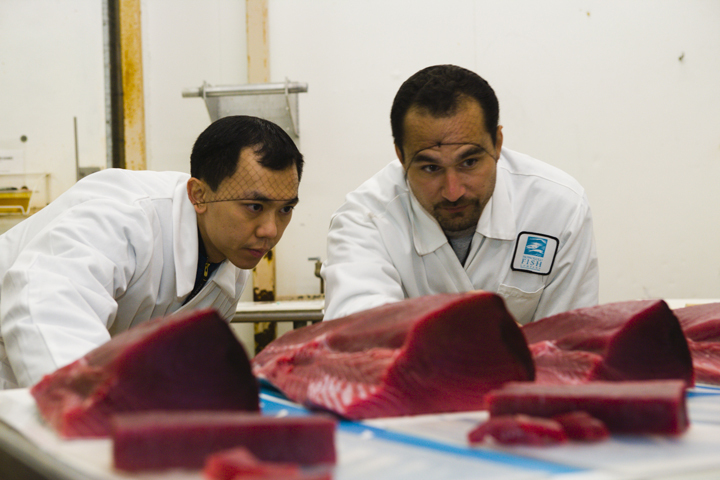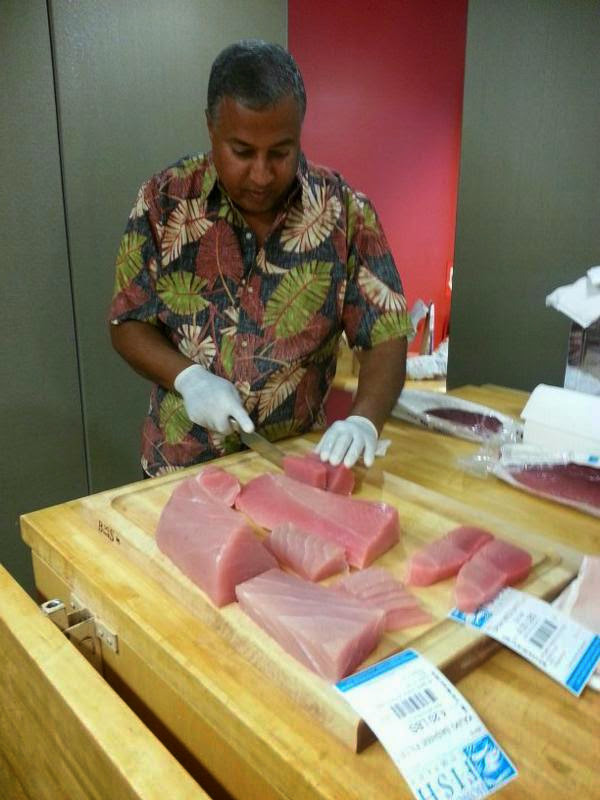
Getting to know a fishmonger: Learn about high-grade line-caught Pacific fresh fish from a fishmonger
06 August 2024Chefs don’t have to live in Hawaii to receive high-grade line-caught Pacific water fresh fish.
By Lisa Parrish, GMC Editor
Feedback & comments: This email address is being protected from spambots. You need JavaScript enabled to view it.
 Fresh fish with exquisite taste caught using hooks and line is so important to fishmonger Wayne Samiere, CEO and founder of Honolulu Fish Company, that he stakes his reputation on it with every piece of fresh fish shipped from his company to chefs around the United States.
Fresh fish with exquisite taste caught using hooks and line is so important to fishmonger Wayne Samiere, CEO and founder of Honolulu Fish Company, that he stakes his reputation on it with every piece of fresh fish shipped from his company to chefs around the United States.
HFC is a direct distributor of sashimi-grade and Pacific water fish. Samiere and his team hand-select products from the Honolulu Fish Market that meet the company’s quality and environmental-impact standards. The high-grade seafood arrives in kitchens within 24 to 48 hours of being shipped in custom boxes that keep the product at 40 degrees or less for two days.
“High-quality fish has a visual appeal in color, smell and texture.” Samiere explained. “At HFC, the product standard is based on eating fish raw.” Samiere selects his company’s products by noting the fish’s smell, water content, meat texture and blood color.
“High-grade fish should smell like a mix of fresh fish and ocean and seaweed,” he said. “Smell is the best tool. Decomposing and older fish smells like strong fish, egg and fish oil.”
He added that he looks for fish harvested at its peak meaning the meat contains a lower water content and overall texture firmness. He said that older, lower-quality fish have a limp and soft texture.
He also looks for bright red blood. “Blood begins to oxidize quickly. Fresh, high-quality fish have red to bright red bloodline. Older, lower-quality fish will have brown bloodline and no blood or brownish blood,” he noted.
Samiere has always had a love of all things living in oceans and waters and began his career as a marine biologist. “I love fishing and aquaculture. That love of fish evolved into a business to share my passion with customers and create great products.”
His scientific background has informed his business’s commitment to only select products from boats that catch fish using ecologically friendly hooks and line. “My fisheries biology experience gave me a deep insight into the size of fish populations and harvest levels that do not affect the reproductive capability of the population. I strongly believe harvesting fish can be done in a way that benefits the fish population and at the same time creates great fish products.”
Long-line hook fishing adds bait to a single fishhook on a line with additional hooks. This method catches one fish in a school of fish and not the entire school as is the practice with habitat-destructive trawl, trap or net fishing. “We only buy hook-caught fish. And, upon inspection at the boat and before we purchase, it is very clear from the fish’s outer condition if it was not hook-caught,” he noted.
 Just as a chef should know his or her fishmonger, Samiere is well acquainted with the boats and fishermen from whom he buys his product. HFC purchasers only buy from fisheries monitored by a governmental agency charged with creating management guidelines. Samiere commented, “Before we begin a purchase relationship with a fish source, we ask the fishermen to show or describe their harvest methods as well as discuss their experience in fisheries.”
Just as a chef should know his or her fishmonger, Samiere is well acquainted with the boats and fishermen from whom he buys his product. HFC purchasers only buy from fisheries monitored by a governmental agency charged with creating management guidelines. Samiere commented, “Before we begin a purchase relationship with a fish source, we ask the fishermen to show or describe their harvest methods as well as discuss their experience in fisheries.”
Samiere offers advice to young cooks beginning their career, “For every popular type of fish – tuna, swordfish, and halibut – there are 100 other fish products with a similar taste and texture. Non-targeted species of fish always have populations that are huge and harvest levels extremely low.” He also suggested chefs consider other delicious and rich parts of fish that are normally thrown out in Western countries while Asian countries consider them delicacies. “There is a huge potential in getting up to 25 percent more product from existing fisheries and harvests if menus supported nontraditional cuts and forms.”
He concluded with, “In my career, I have met many, many people like myself, that love to produce great products and have a great respect for the natural resource that we make our living from. Find a fishmonger who is proud to put their name or their brand on a product. Find a fishmonger that wants to be known as the best. Our job is to know fish, fishermen, boats, freshness, grading and selection.”
The Honolulu Fish Company is a certified Minority Business Enterprise. Photos courtesy of HFC.
